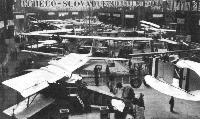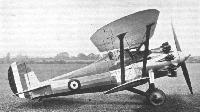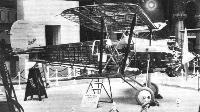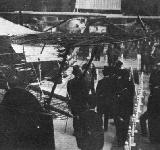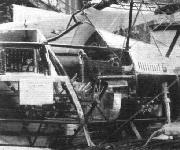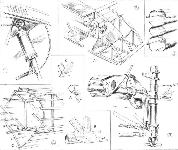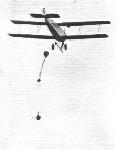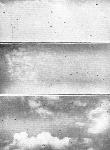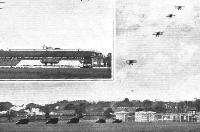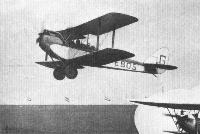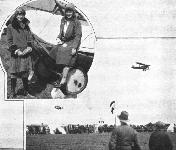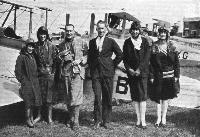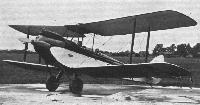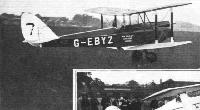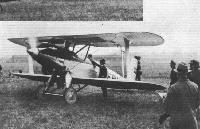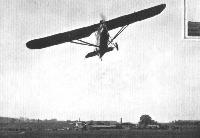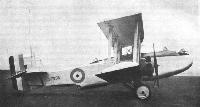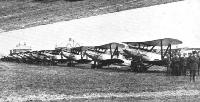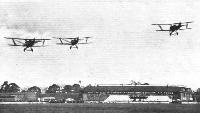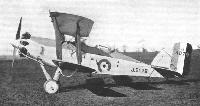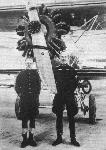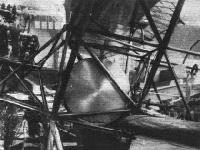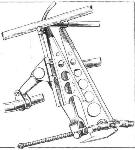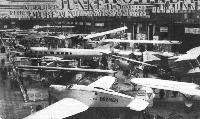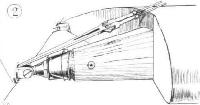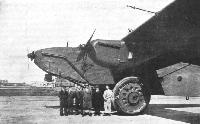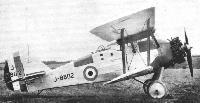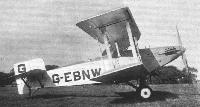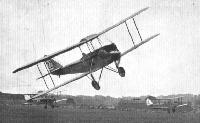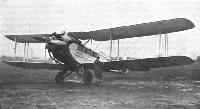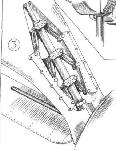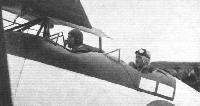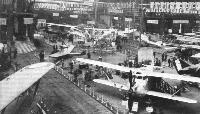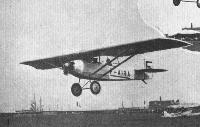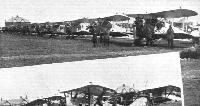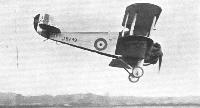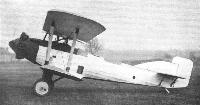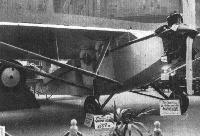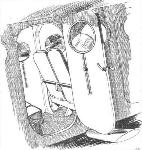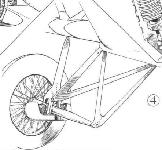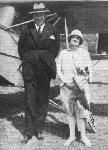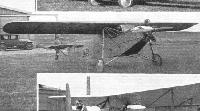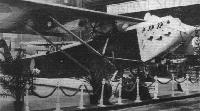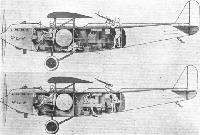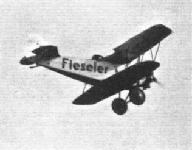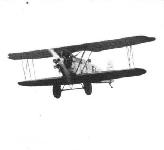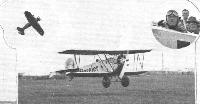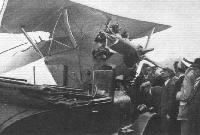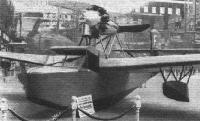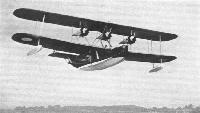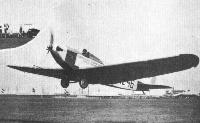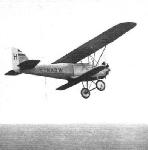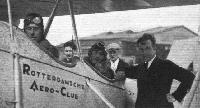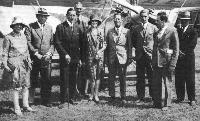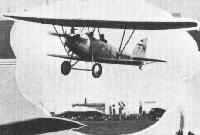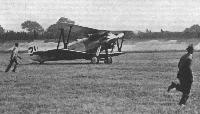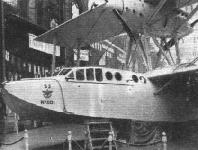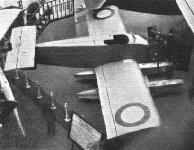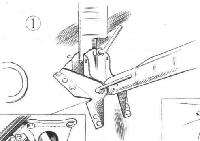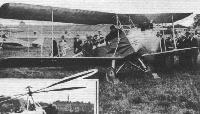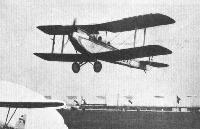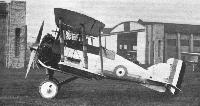Фотографии
-
BELGIAN RECORD WITH ENGLISH ENGINE: This is Adjutant Crooy and Sgt. Groenen in their D.H.9 fitted with the Armstrong-Siddeley "Puma" engine (supplied by A.D.C. Aircraft, Ltd.), making their recent duration record of 60 hours 7 mins. 32 secs. The other picture shows the machine being refuelled during the flight.
Самолёты на фотографии: De Havilland D.H.9 - Великобритания - 1917
-
Регистрационный номер: L-BAAC IN THE GRAND PALAIS: View looking South. In the foreground the Aero cabin biplane, as used on Czechoslovak air lines. Beyond, the CAMS flying-boat. On the right, the tail of the twin-hull Savoia S.55.
Самолёты на фотографии: Aero A.23 / A.38 - Чехословакия - 1926CAMS CAMS 51 / CAMS 53 / CAMS 56 - Франция - 1926Savoia-Marchetti / SIAI S.55 - Италия - 1924
-
Прототип Bulldog, обозначавшийся как Mk I, сфотографирован в Филтоне в мае 1927 года. В кабине - Сирил Увинс. Самолет имеет небольшой руль направления, который вскоре заменили на руль большей площади, а также установили крылья большего размаха - для высотных испытаний в Фарнборо.
Самолёты на фотографии: Bristol Bulldog - Великобритания - 1927
-
The prototype Bulldog I, construction number 7155 - it never carried an RAF serial. Powered by a Bristol Jupiter VII, it first flew on May 17, 1927.
Bristol Bulldog (Bristol "Jupiter"). The Bristol Aeroplane Co., as producers of both aircraft and aero engines, has a splendid opportunity for close cooperation between the two branches, and perhaps in no other Bristol machine produced has this fact been made fuller use of than in the "Bulldog," a single-seater day and night fighter of all-metal construction. The manner in which the "Jupiter" engine has been streamlined should be particularly noted. Not only is the extreme "nose" very pointed, and fairings placed in front of as well as behind the cylinder heads, but the overhead rockers have been enclosed in casings. Similar care has been taken in the design of the rest of the machine.Самолёты на фотографии: Bristol Bulldog - Великобритания - 1927
-
"THE CAMEO OF THE SHOW": This was the expression used by a French engineer in reference to the Bristol Single-seater Fighter. The machine is exhibited stripped to the centre-line.
Самолёты на фотографии: Bristol Bulldog - Великобритания - 1927
-
THE PRESIDENT OF THE FRENCH REPUBLIC AT THE GRAND PALAIS: Admiring the Bristol Single-seater Fighter.
Самолёты на фотографии: Bristol Bulldog - Великобритания - 1927
-
AIRCRAFT WIRELESS: The Marconi installation in the Bristol Single-seater Fighter.
Самолёты на фотографии: Bristol Bulldog - Великобритания - 1927
-
THE BRISTOL SINGLE-SEATER FIGHTER, BRISTOL "JUPITER" ENGINE: Three-quarter rear view.
Самолёты на фотографии: Bristol Bulldog - Великобритания - 1927
-
SOME CONSTRUCTIONAL DETAILS OF THE BRISTOL SINGLE-SEATER FIGHTER: 1, Attachment of the oleo undercarriage leg to top longeron. 2, A wing root, showing metal construction and form of attachment. The spar section shown in 3 is a recent development and depends mainly on the grip of the curled edges for locking flanges to webs, the number of rivets used being very small. 4, A general view of the construction of the rear portion of the fuselage, with details shown enlarged at A, B and C. The somewhat unusual trimming arrangement for the cantilever tail plane is illustrated in 5.
Самолёты на фотографии: Bristol Bulldog - Великобритания - 1927
-
Регистрационный номер: S-AAAC, SE-AAC THE STOCKHOLM-LONDON NIGHT AIR MAIL: As reported in a previous issue of "Flight," the Swedish Aerotransport Co. inaugurated a night air mail service between Stockholm and London, on June 18. Our illustration shows the Junkers F.13 machine which made the first trip, piloted by Liljeberg; it left Stockholm at 4 p.m., June 18, and arrived at Croydon at 14.45 p.m., June 19 (having been delayed two hours at Amsterdam owing to a broken speed indicator). On this flight 500 registered and 3,000 ordinary letters were carried.
Самолёты на фотографии: Junkers F 13 - Германия - 1919
-
The "Avia" B.H.33 is a Single-seater Fighter with Walter "Jupiter" engine.
Самолёты на фотографии: Avia BH-33 - Чехословакия - 1927
-
Close view of Miss June leaving the Avro on her record low jump with a "Guardian Angel" parachute from 150 ft. She landed near the crowd, who were delighted to meet her.
Самолёты на фотографии: Avro Avro 504 - Великобритания - 1913
-
BLACKPOOL AIR PAGEANT: Armstrong-Whitworth "Siskins," single-seater fighters, circling the aerodrome in follow-my-leader style.
Самолёты на фотографии: Armstrong Whitworth Siskin - Великобритания - 1921
-
AIR FIGHTER EVOLUTIONS: Armstrong-Whitworth "Siskins" (Jaguars) belonging to Squadrons Nos. 19, 29 and 56, at wing evolutions. Two squadrons formed a large circle and the third squadron dived through it
Самолёты на фотографии: Armstrong Whitworth Siskin - Великобритания - 1921
-
Регистрационный номер: J8633 R.A.F. DISPLAY AT BLACKPOOL: The huge crowd that visited the Blackpool Air Pageant on July 7 were lucky witnesses of a splendid imitation of the R.A.F. Display at Hendon. This view shows the familiar Air Force machines which took part: Armstrong-Whitworth "Siskins"
Самолёты на фотографии: Armstrong Whitworth Siskin - Великобритания - 1921
-
BATTLING AT HENDON: Armstrong-Whitworth "Siskins," belonging to the flight which won the Battle Flight Competition, taxi-ing along the enclosures after victory.
Самолёты на фотографии: Armstrong Whitworth Siskin - Великобритания - 1921
-
DISPLAY FEATURES: Armstrong-Whitworth "Siskins" (Jaguars) diving in line ahead formation to open fire on the enemy transports crawling over the aerodrome.
Самолёты на фотографии: Armstrong Whitworth Siskin - Великобритания - 1921
-
Регистрационный номер: G-EBOS AT THE ROTTERDAM LIGHT 'PLANE MEETING: The take-off and landing competition. 1. Miss O'Brien taking off.
Самолёты на фотографии: De Havilland Moth / D.H.60 - Великобритания - 1925
-
Регистрационный номер: G-EBYZ [2] THE FINISH OF THE KING'S CUP AIR RACE: Capt. W. L. Hope "crossing the line" at Brooklands on his D.H. "Moth" (D.H. "Gipsy")
Самолёты на фотографии: De Havilland Moth / D.H.60 - Великобритания - 1925
-
STAG LANE SPORTS: The D.H. "Moths" flying home during the obstacle race.
Самолёты на фотографии: De Havilland Moth / D.H.60 - Великобритания - 1925
-
BLACKPOOL: (Inset) Miss O'Brien, sitting on the leading edge of her D.H. "Moth," and her passenger, Miss Mawdsley, and winning the Daily Dispatch Nomination Handicap.
Самолёты на фотографии: De Havilland Moth / D.H.60 - Великобритания - 1925
-
LADY HEATH'S AERIAL AT HOME: On July 18 Sir James and Lady Heath gave a Garden Party at Croydon Aerodrome. The guests were taken for flights during the afternoon, and many had their "bapteme de l'air" on this occasion. In this photograph is seen Miss O'Brien's "Moth" about to take up Mrs. Patrick Ness.
Самолёты на фотографии: De Havilland Moth / D.H.60 - Великобритания - 1925
-
BRITISH SUCCESS AT ROTTERDAM MEETING: The British team standing in front of Lady Heath's "Moth," with the other two "Moths" in the background. In the group, from left to right: Miss O'Brien and her passenger, the Hon. Miss M. K. Leith; Capt. Cordes and his passenger, Mr. Cooke; Lady Heath and her passenger and private secretary.
Самолёты на фотографии: De Havilland Moth / D.H.60 - Великобритания - 1925
-
A TEAM IN THE RELAY RACE: In the foreground, Lady Heath's "Cirrus-Moth." In the centre, the Demonty-Poncelet, and in the background one of the Pander machines.
Самолёты на фотографии: De Havilland Moth / D.H.60 - Великобритания - 1925Pander E - Нидерланды - 1926
-
Самолёты на фотографии: De Havilland Moth / D.H.60 - Великобритания - 1925
-
Mr. Norman Jones starting up his D.H. "Moth" (Cirrus) at Blackpool, where he won the Owner-Pilots' Handicap Race at 97 m.p.h.
Самолёты на фотографии: De Havilland Moth / D.H.60 - Великобритания - 1925
-
THIRD AND FIRST: Miss W. E. Spooner lands safely at Brooklands in her D.H. "Moth" ("Cirrus I") after a plucky fight for first place in the King's Cup race. She was placed third in this, and won also the Siddeley Trophy.
Самолёты на фотографии: De Havilland Moth / D.H.60 - Великобритания - 1925
-
THE KING'S CUP AIR RACE: First and last away from Hendon. At the top E. E. Stammers and H. M. Yeatman (No. 30) are first away in their D.H. "Moths" ("Cirrus I"), at 8 a.m.
Самолёты на фотографии: De Havilland Moth / D.H.60 - Великобритания - 1925
-
Регистрационный номер: G-EBYZ [2] SOME MORE COMPETING MACHINES: The winning D.H. "Moth" (D.H. "Gipsy"), piloted by W. L. Hope. Hope's "Moth" is fitted with the new de Havilland "Gipsy" engine, of which three were entered and all of which completed the course.
Самолёты на фотографии: De Havilland Moth / D.H.60 - Великобритания - 1925
-
OPEN HANDICAP: Miss W.S. Brown, (centre) on her Avro "Avian" (Cirrus), winning the Open Handicap from Capt. Baker on an Avro "Avian" and Flight-Lieut. T. Rose on the D.H. "Moth" by two seconds.
Самолёты на фотографии: Avro Avian / Type 594/616 - Великобритания - 1926De Havilland Moth / D.H.60 - Великобритания - 1925
-
STUNTING AT HENDON: Two D.H. "Moths" crossing the aerodrome wing to wing, one inverted and the other in normal position. Their pilots were Flying Officers Boyle and Atcherly.
Самолёты на фотографии: De Havilland Moth / D.H.60 - Великобритания - 1925
-
Регистрационный номер: G-EBND [3] Squadron-Leader J. Noakes applying his crazy flying inventiveness on the Avro "Avenger" at the Air Pageant, Blackpool.
Самолёты на фотографии: Avro Avenger / Type 566 - Великобритания - 1926
-
Регистрационный номер: G-EBND [3] FASTEST, IF NOT FIRST: Flying-Officer Joseph Summers, who won the special prize of ?100 (presented by Mr. Alan S. Butler) for the fastest time over the course. Piloting the Avro "Avenger" (Napier "Lion") he averaged 149 m.p.h.
Самолёты на фотографии: Avro Avenger / Type 566 - Великобритания - 1926
-
Регистрационный номер: G-EBND [3] THE KING'S CUP AIR RACE: Flying-Officer Joseph Summers, on the Avro "Avenger" (Napier "Lion") who started scratch at 11.23 a.m.
Самолёты на фотографии: Avro Avenger / Type 566 - Великобритания - 1926
-
Регистрационный номер: G-EBTE Самолёты на фотографии: Parnall Imp - Великобритания - 1927
-
Регистрационный номер: G-EBYY The photograph shows the Cierva "Autogiro," in which the lift is obtained not by fixed wings but from the vanes of a rotating windmill.
Самолёты на фотографии: Cierva/Avro C.8 / C.9 - Великобритания - 1926
-
THE KING'S CUP AND SIDDELEY TROPHY: Some competitors starting from Hendon on the first stage. R. G. Cazalet on a Widgeon III ("Cirrus II"), and just behind him Flight-Lieut. Ragg on an Avian ("Cirrus").
Самолёты на фотографии: Avro Avian / Type 594/616 - Великобритания - 1926Westland Widgeon - Великобритания - 1924
-
Регистрационный номер: J7938 THE BOULTON & PAUL "SIDESTRAND": Side view. Note the three gun positions, and more particularly that for the aft gunner firing under the tail.
The prototype Sidestrand, J7938, made its maiden flight in 1926. It became the RAF’s first twin-engined day bomber since the D.H.10 and was the Service’s first medium bomber.Самолёты на фотографии: Boulton Paul Sidestrand / P.29 - Великобритания - 1926
-
The Italian Fiat monoplanes (Fiat engines) on their arrival at Hornchurch on June 28 after the non-stop flight from Italy, led by General Balbo, Under-Secretary for Air, Italy.
Самолёты на фотографии: Ansaldo A-115 / A-120 Ady - Италия - 1925
-
Регистрационный номер: G-CAJI FOR THE ATLANTIC FLIGHT: The Dornier-Napier all-metal flying-boat, fitted with two 450 h.p. Napier "Lion" engines, in which Capt.F. T.Courtney is attempting a return flight across the Atlantic. It is equipped with Marconi wireless.
Самолёты на фотографии: Dornier Do.J Wal - Германия - 1922
-
EXTREMES: Pterodactyl (Genet) in flight
Самолёты на фотографии: Westland-Hill Pterodactyl - Великобритания - 1925
-
R.A.F. DISPLAY AT BLACKPOOL: The huge crowd that visited the Blackpool Air Pageant on July 7 were lucky witnesses of a splendid imitation of the R.A.F. Display at Hendon. This view shows the familiar Air Force machines which took part: Fairey "Foxes"
Самолёты на фотографии: Fairey Fox - Великобритания - 1925
-
AIR FORCE DISPLAY: Fairey "Foxes" at drill movements in formation. Each Squadron passed in succession from different directions performing similar drill orders.
Самолёты на фотографии: Fairey Fox - Великобритания - 1925
-
DISPLAY FEATURES: Fairey "Foxes" diving over the enclosures to demonstrate low bombing at speed.
Самолёты на фотографии: Fairey Fox - Великобритания - 1925
-
Регистрационный номер: J9078 Самолёты на фотографии: Westland Wapiti - Великобритания - 1927
-
THE "JUPITER" AND NOBILE'S RESCUER: Our picture shows Lieut. Lundborg, of the Swedish Army (right), with his mechanic and a Fokker C.V. fitted with a Bristol "Jupiter" engine. It was Lieut. Lundborg who rescued Gen. Nobile, and who was himself stranded with the remaining members of the Italia's crew when he damaged his machine on landing after his second rescue trip
Самолёты на фотографии: Fokker C.V / C.VI - Нидерланды - 1924
-
A FOKKER-"JAGUAR" COMBINATION: The Fokker C.VI Observation biplane, fitted, with an Armstrong-Siddeley "Jaguar" supercharged engine. This machine is a development of the Fokker C.V.D., previously described in "FLIGHT."
Самолёты на фотографии: Fokker C.V / C.VI - Нидерланды - 1924
-
A VERY FINE SQUADRON: The two photographs show a flight of Fokker C.V.'s, which gave some excellent demonstrations of formation flying. Under the leadership of Capt. Versteegh, the Dutch pilots approach more nearly to British R.A.F. standards than any we have seen.
Самолёты на фотографии: Fokker C.V / C.VI - Нидерланды - 1924
-
The "dropping" petrol tank of the Fokker C.V.
Самолёты на фотографии: Fokker C.V / C.VI - Нидерланды - 1924
-
The tail-trimming gear on the Fokker C.V. The pilot rotates the worm shaft, which operates the crank arm that engages with the leading edge of the tail plane.
Самолёты на фотографии: Fokker C.V / C.VI - Нидерланды - 1924
-
IN THE GRAND PALAIS: View looking North. In the foreground the Junkers W.33 type, "Bremen." Some distance behind that the large Farman passenger carrier.
Самолёты на фотографии: Farman F.180 Oiseau Bleu - Франция - 1928Junkers W 33 / W 34 / Ju.46 - Германия - 1926
-
AIR FORCE DISPLAY: Hawker "Horsleys" at drill movements in formation. Each Squadron passed in succession from different directions performing similar drill orders.
Самолёты на фотографии: Hawker Horsley / Dantorp - Великобритания - 1925
-
Эталонный истребитель Gambet, созданный на базе Gamecock и оснащенный посадочным крюком и масляными амортизаторами шасси, был куплен фирмой "Nakajima Hikoki К.К.".
Gloster Gambet single-seater deck fighter with Jupiter engine.Самолёты на фотографии: Gloster Gambet - Великобритания - 1927
-
VARIOUS WAYS OF USING RUBBER SHOCK ABSORBERS: 2, the compression rubbers on the Albatros "ASS."
Самолёты на фотографии: Albatros L.75 Esel - Германия - 1928
-
ONE OF PARIS SHOW ITEMS: 2. Attachment of wooden spar to fuselage on Albatros "ASS"
Самолёты на фотографии: Albatros L.75 Esel - Германия - 1928
-
Регистрационный номер: J7557 [2] The Inflexible photographed at RAF Martlesham Heath early in 1928. The central figure in the group dwarfed by the port wheel is Sqn Ldr Rollo A. de Haga Haig.
Самолёты на фотографии: Beardmore Inflexible - Великобритания - 1928
-
Регистрационный номер: J7557 [2] EXTREMES: Beardmore "Inflexible" (Condors) leading the parade.
Самолёты на фотографии: Beardmore Inflexible - Великобритания - 1928
-
Регистрационный номер: J8802 Самолёты на фотографии: Armstrong Whitworth Atlas / Ajax - Великобритания - 1925
-
Регистрационный номер: G-EBNW, N239 Самолёты на фотографии: Avro Buffalo / Type 571/572 - Великобритания - 1927
-
Регистрационный номер: G-EBSK, G-EBXX BLACKPOOL: General View of the Machine Park, with the private light aeroplanes in the foreground, of which there were about 50, and the Royal Air Force machines, which included night bombers, day bombers and single-seater fighters, in the distance.
Самолёты на фотографии: Avro Avian / Type 594/616 - Великобритания - 1926De Havilland Gipsy Moth / Moth X - Великобритания - 1928
-
THE KING'S CUP AND SIDDELEY TROPHY: Some competitors starting from Hendon on the first stage. Bernard Martin on the Avro Avian (No. 22), Wing-Com. S. W. Smith on the D.H. Moth X (No. 15), and Capt. G. de Havilland on another Moth X, take off together.
Самолёты на фотографии: Avro Avian / Type 594/616 - Великобритания - 1926De Havilland Gipsy Moth / Moth X - Великобритания - 1928
-
THE KING'S CUP AND SIDDELEY TROPHY: Some competitors starting from Hendon on the first stage. C. E. F. Boyes (left) and E. W. Percival off together, both on Avians fitted respectively with Armstrong-Siddeley "Genet II" and A.D.C. "Cirrus III" engines.
Самолёты на фотографии: Avro Avian / Type 594/616 - Великобритания - 1926
-
Регистрационный номер: G-EBTL Самолёты на фотографии: De Havilland Giant Moth / D.H.61 - Великобритания - 1927
-
ONE OF PARIS SHOW ITEMS: 1. The unusual tail skid on the Bernard Single-seater Fighter.
Самолёты на фотографии: Bernard Bernard 20 - Франция - 1929
-
VARIOUS WAYS OF USING RUBBER SHOCK ABSORBERS: 3, the enclosed rubbers in the undercarriage leg of the Bernard single-seater fighter.
Самолёты на фотографии: Bernard Bernard 20 - Франция - 1929
-
COMMERCIAL TYPE OF AIRCRAFT AT THE PARIS SHOW: The Bernard monoplane
Самолёты на фотографии: Bernard Bernard 190 - Франция - 1928
-
Регистрационный номер: G-EBVO THE KING'S CUP AND SIDDELEY TROPHY: Some competitors starting from Hendon on the first stage. Sqdn.-Ldr. J. Noakes gets away on the Blackburn "Lincock" (Armstrong-Siddeley "Lynx").
Самолёты на фотографии: Blackburn Lincock / F.2 - Великобритания - 1928
-
The photograph shows the Blackburn "Bluebird" with Armstrong-Siddeley "Genet" engine. The machine is a light 'plane, but is unusual in that pilot and passenger sit side by side.
Самолёты на фотографии: Blackburn Bluebird / L.1 - Великобритания - 1924
-
The King's Cup Air Race: Flying Officer Atcherley (left) and his passenger in the Gloster "Grebe" (Armstrong-Siddeley "Jaguar") which was the first machine in at Glasgow on Section I of the race.
Самолёты на фотографии: Gloster Grebe - Великобритания - 1923
-
SLOTTED WINGS: Two views of the Vickers "Virginia" bomber fitted with the Handley-Page slotted wings. On the left, the slots are shown closed, and on the right, open.
Самолёты на фотографии: Vickers Virginia - Великобритания - 1922
-
Регистрационный номер: F-AIXV [2] A GENERAL VIEW: In the foreground the Breguet commercial machine. On the left may be seen the port wings of the Levasseur torpedo plane, and farther back, the little Liore & Olivier two-seater flying-boat.
Самолёты на фотографии: Breguet Br.280 - Франция - 1928Levasseur PL.7 / PL.14 - Франция - 1926Liore et Olivier LeO H.18 / H.22 / H.23 - Франция - 1928
-
Регистрационный номер: F-AIXV [2] COMMERCIAL TYPE OF AIRCRAFT AT THE PARIS SHOW: The Breguet 280 T.
Самолёты на фотографии: Breguet Br.280 - Франция - 1928
-
The cabin of the Breguet 280 T. The backs of the seats are supported on two leaf springs.
Самолёты на фотографии: Breguet Br.280 - Франция - 1928
-
Регистрационный номер: F-AIRA AT THE ROTTERDAM LIGHT 'PLANE MEETING: The take-off and landing competition. 4. The Caudron monoplane taking off.
Самолёты на фотографии: Caudron C.109 / C.110 - Франция - 1925
-
Регистрационный номер: J7515, G-EBMA R.A.F. DISPLAY AT BLACKPOOL: The huge crowd that visited the Blackpool Air Pageant on July 7 were lucky witnesses of a splendid imitation of the R.A.F. Display at Hendon. This view shows the familiar Air Force machines which took part: Hawker "Woodcocks"
Самолёты на фотографии: Hawker Woodcock - Великобритания - 1923
-
Регистрационный номер: J8299 Самолёты на фотографии: Hawker Woodcock - Великобритания - 1923
-
BATTLING AT HENDON: (left) One of the bombers beginning its dive in flames after attack by fighters during a bombing raid. (Right) Another bomber meets the same fate.
Самолёты на фотографии: Handley Page Hyderabad/H.P.24 / Hinaidi/H.P.33 / Clive/H.P.35 - Великобритания - 1923
-
AIR BATTLE AT BLACKPOOL: (Above) A Handley Page "Hyderabad" night bomber descending in flames after the Battle for Blackpool; and (below) three of the same type bombers taking off for the affray.
Самолёты на фотографии: Handley Page Hyderabad/H.P.24 / Hinaidi/H.P.33 / Clive/H.P.35 - Великобритания - 1923
-
NIGHT WORK: Handley Page "Hyderabad" night bombers passing in open formation during the fly-past of night bombers.
Самолёты на фотографии: Handley Page Hyderabad/H.P.24 / Hinaidi/H.P.33 / Clive/H.P.35 - Великобритания - 1923
-
R.A.F. DISPLAY AT BLACKPOOL: The huge crowd that visited the Blackpool Air Pageant on July 7 were lucky witnesses of a splendid imitation of the R.A.F. Display at Hendon. This view shows the familiar Air Force machines which took part: Handley-Page "Hyderabads."
Самолёты на фотографии: Handley Page Hyderabad/H.P.24 / Hinaidi/H.P.33 / Clive/H.P.35 - Великобритания - 1923
-
Регистрационный номер: J8674 Самолёты на фотографии: Gloster Goring - Великобритания - 1927
-
THE HANDLEY PAGE "HARROW II": Three-quarter front view.
Самолёты на фотографии: Handley Page Harrow / H.P.31 - Великобритания - 1926
-
Регистрационный номер: J9068 Самолёты на фотографии: Fairey Fairey IIIF - Великобритания - 1926
-
AIR FORCE DISPLAY: Fairey IIIF's at drill movements in formation. Each Squadron passed in succession from different directions performing similar drill orders
Самолёты на фотографии: Fairey Fairey IIIF - Великобритания - 1926
-
THE LARGEST COMMERCIAL AEROPLANE IN THE SHOW: The Farman 1,000 h.p. type F.180 has seating accommodation for up to 22 passengers.
Самолёты на фотографии: Farman F.180 Oiseau Bleu - Франция - 1928
-
COMMERCIAL TYPE OF AIRCRAFT AT THE PARIS SHOW: The small Farman four-passenger monoplane
Самолёты на фотографии: Farman F.190 / F.390 - Франция - 1928
-
A peep into the little Farman four-passenger monoplane. Note the method of raising and lowering the window.
Самолёты на фотографии: Farman F.190 / F.390 - Франция - 1928
-
VARIOUS WAYS OF USING RUBBER SHOCK ABSORBERS: 4, one-half of the Fiat biplane chassis.
Самолёты на фотографии: FIAT BR - Италия - 1919
-
LADY HEATH'S SEAPLANE RECORD: The Short "Mussel" (Cirrus Mk. II) taking off from the Medway at Rochester to attempt the record on July 14, piloted by Lady Heath, with Miss S. O'Brien as passenger. It reached 13,400 ft.
Самолёты на фотографии: Short Mussel / S.7 - Великобритания - 1926
-
"TINY AND TOT": Mr. and Mrs. F. Koolhoven, standing by the new F.K.41 monoplane.
Самолёты на фотографии: Koolhoven FK-41 - Нидерланды - 1928
-
Регистрационный номер: H-NAER SOME AIRCRAFT TYPES AT THE ROTTERDAM MEETING: 3, the new Koolhoven monoplane, type F.K. 41. This is a three-seater touring machine.
Самолёты на фотографии: Koolhoven FK-41 - Нидерланды - 1928
-
A New Fokker Type: The C.VIII is a strut-braced parasol monoplane designed for long-distance reconnaissance.
Самолёты на фотографии: Fokker C.VIII / C.VIII-W - Нидерланды - 1928
-
Interior arrangement of the Fokker C.VIII: The lower view shows position of crew while working, and the upper, the fighting positions of the two gunners.
Самолёты на фотографии: Fokker C.VIII / C.VIII-W - Нидерланды - 1928
-
Herr Fieseler, the German pilot, leaving Blackpool in his machine after the meeting at which he demonstrated his vertical figure of eight, rolling with horizontal fuselage, &c.
Самолёты на фотографии: Raab-Katzenstein RK.1 Schwalbe / RK.2 Pelikan / RK.9 Grasmucke - Германия - 1926
-
Регистрационный номер: D-1212 [2] FLYING AT WAALHAVEN: Herr Fieseler on his Raab-Katzenstein.
Самолёты на фотографии: Raab-Katzenstein RK.1 Schwalbe / RK.2 Pelikan / RK.9 Grasmucke - Германия - 1926
-
Регистрационный номер: D-1453 SOME AIRCRAFT TYPES AT THE ROTTERDAM MEETING: 2, a Raab-Katzenstein "Pelikan" with "Cirrus" engine.
Самолёты на фотографии: Raab-Katzenstein RK.1 Schwalbe / RK.2 Pelikan / RK.9 Grasmucke - Германия - 1926
-
Регистрационный номер: D-1212 [2] AIR PAGEANT: (Left Inset) Herr Fieseler's machine on its back at Blackpool, in which position it flew for the greater part of his exhibition. (Right Inset) Herr Fieseler and (centre) his machine taking-off.
Самолёты на фотографии: Raab-Katzenstein RK.1 Schwalbe / RK.2 Pelikan / RK.9 Grasmucke - Германия - 1926
-
Регистрационный номер: J6989 A King's Cup Non-Starter: The Hawker "Heron" (pilot, Flight-Lieut. P. W. Bulman), which was one of the favourites, had the misfortune to run into a car while taxying to the starting line at Hendon, with the result shown.
Самолёты на фотографии: Hawker Heron / Hornbill / Hawfinch / Hoopoe - Великобритания - 1925
-
SOME QUICK-RELEASES AT THE PARIS SHOW: In 4 is shown one side of the "droppable" undercarriage of the P. Levasseur torpedo-plane. Details are shown in 2 and 3. The bayonet joint in the telescopic leg is released first. The wheel and strut then drop, and in doing so allow the fitting on axle and radius rod to fall out through the slot in the fork. It should be pointed out that 2 and 3 are viewed from the back, while 4 is seen from in front.
Самолёты на фотографии: Levasseur PL.7 / PL.14 - Франция - 1926
-
A LIGHT FLYING-BOAT: The Liore and Olivier Leo 18 is one French firm's interpretation of the private owner's seaplane. With the two seats arranged side by side, conduite interieure, and a "pusher" airscrew, the machine should be clean, comfortable, and quiet.
Самолёты на фотографии: Liore et Olivier LeO H.18 / H.22 / H.23 - Франция - 1928
-
Регистрационный номер: S1151 Самолёты на фотографии: Supermarine Southampton / Solent - Великобритания - 1925
-
THE SUPERMARINE "SOLENT"
Самолёты на фотографии: Supermarine Southampton / Solent - Великобритания - 1925
-
COMMERCIAL TYPE OF AIRCRAFT AT THE PARIS SHOW: The Potez 32.
Самолёты на фотографии: Potez Potez 32 / 33 - Франция - 1928
-
Регистрационный номер: G-EBMG Самолёты на фотографии: Saunders Medina / A.4 - Великобритания - 1926
-
Регистрационный номер: N186 Самолёты на фотографии: Saunders Valkyrie / A.3 - Великобритания - 1926
-
Регистрационный номер: O-BAJC, O-BAJD SOME AIRCRAFT TYPES AT THE ROTTERDAM MEETING: 1, two Belgian R.S.V. school machines with Renard engines. (RSV 32/100)
Самолёты на фотографии: Stampe et Vertongen RSV.32 / RSV.26 - Бельгия - 1923
-
SOME AIRCRAFT TYPES AT THE ROTTERDAM MEETING: 4, a Belgian Light 'Plane. (RSV 26/100)
Самолёты на фотографии: Stampe et Vertongen RSV.32 / RSV.26 - Бельгия - 1923
-
THE VICKERS "VIVID"
Самолёты на фотографии: Vickers Vixen / Venture / Valparaiso / Valiant - Великобритания - 1923
-
SOME MORE COMPETING MACHINES: The Bristol 83E (Bristol "Titan I") piloted by Sqdn.-Leader A. G. Jones-Williams. The "Bristol" training machine is fitted with the new "Titan" engine, which is composed in the main of "Jupiter" parts, and has five "Jupiter" cylinders.
Самолёты на фотографии: Bristol Taxiplane / Primary Trainer - Великобритания - 1923
-
STUNTING AT HENDON: Avro-Lynx machines flown by Flying Officers Bremridge and Campbell of No. 2 Flying Training School.
Самолёты на фотографии: Avro Avro 504N - Великобритания - 1920
-
Регистрационный номер: G-EBOJ Самолёты на фотографии: Martinsyde A.D.C.1 / Nimbus - Великобритания - 1924
-
AT THE ROTTERDAM LIGHT 'PLANE MEETING: The take-off and landing competition. 5. The little Klemm-Daimler "zooms."
Самолёты на фотографии: Daimler L 20 - Германия - 1924
-
VARIOUS WAYS OF USING RUBBER SHOCK ABSORBERS: 1, on the little Klemm-Daimler.
Самолёты на фотографии: Daimler L 20 - Германия - 1924
-
Регистрационный номер: H-NADW [2] FLYING AT WAALHAVEN: One of the Panders
Самолёты на фотографии: Pander E - Нидерланды - 1926
-
The right spirit: Trying out each other's machines was a favourite pastime at Waalhaven. Lady Heath is here seen after a flight in one of the Pander machines. In the front cockpit is M. Schmidt Crans, and standing by the side of the machine, M. Slot, constructor of the Pander aeroplanes.
Самолёты на фотографии: Pander E - Нидерланды - 1926
-
THE D.C.A. AT WAALHAVEN: Sir Sefton Brancker paid a visit to the Rotterdam Meeting on Sunday last, arriving with a party on a Fokker placed at his disposal by the K.L.M. He is here seen, in front of one of the Pander machines with, among others, M. C. Kolff, Miss O'Regan, M. Schmidt Crans and M. de Niet.
Самолёты на фотографии: Pander E - Нидерланды - 1926
-
Регистрационный номер: H-NADW [2] AT THE ROTTERDAM LIGHT 'PLANE MEETING: The take-off and landing competition. 3. One of the Panders doing the landing.
Самолёты на фотографии: Pander E - Нидерланды - 1926
-
De Havilland "Hound" (Napier "Lion"). Another "General Purpose" machine, also fitted with the Napier "Lion" engine. Although an obvious De Havilland product the "Hound" represents several departures, and particularly should its clean lines be noted. So good are these that the performance of the "Hound" is quite exceptionally good. In fact, it has been jestingly remarked that the performance is "too good" for a machine of this type. There is nothing exceptional in the general design, no startling changes in arrangement. The high performance is simply due to careful avoidance of interference effects as far as possible.
Самолёты на фотографии: De Havilland Hound / D.H.65 - Великобритания - 1926
-
Регистрационный номер: G-EBOW SECOND - AND NEARLY FIRST!: C. F. Uwins on the Bristol 101 coming in second at Brooklands. But for compass trouble he might have overhauled Hope.
Самолёты на фотографии: Bristol Bristol 101 - Великобритания - 1927
-
A LONG-RANGE MAIL CARRIER: The C.A.M.S. 53 twin-engined flying-boat, like so many modern French machines, has the pilot's cockpit enclosed.
Самолёты на фотографии: CAMS CAMS 51 / CAMS 53 / CAMS 56 - Франция - 1926
-
THE NON-STOP SOUTH ATLANTIC FLIGHT: The Savoia-Marchetti S 64 monoplane, fitted with a 550 h.p. Fiat A. 22T engine, on which Capt. Ferrarin and Major del Prete made a non-stop flight from Rome to Brazil
Самолёты на фотографии: Savoia-Marchetti / SIAI S.64 - Италия - 1928
-
A TWIN-FLOAT VERSION: The M.B.35 exhibited on the Mureaux stand is primarily a submarine scout, but should also be a useful type as a private owner's machine
Самолёты на фотографии: Besson MB-35 - Франция - 1926
-
SOME QUICK-RELEASES AT THE PARIS SHOW: 1. The type used extensively on the Mureaux M.B.35 for the attachment of wings, floats and struts.
Самолёты на фотографии: Besson MB-35 - Франция - 1926
-
The Simmonds "Spartan" is unusual, in that the wings are so designated that the same spare wing can be used on either side and as top or bottom plane.
Самолёты на фотографии: Simmonds Spartan - Великобритания - 1928
-
Регистрационный номер: J8819 One of the Genet-Moths inverted during one of its climbing rolls in the course of the same remarkable performance by Flying Officers Boyle and Atcherley.
Самолёты на фотографии: De Havilland Genet Moth - Великобритания - 1926
-
EMULATION: (Left) The two Genet-Moths piloted by Flying Officers Boyle and Atcherley in opposite positions; and (right) performing their remarkable slow rolls very low across the Blackpool aerodrome.
Самолёты на фотографии: De Havilland Genet Moth - Великобритания - 1926
-
AT THE ROTTERDAM LIGHT 'PLANE MEETING: The take-off and landing competition. 2. Mr. Gordes landing over the obstacle.
Самолёты на фотографии: De Havilland Gipsy Moth / Moth X - Великобритания - 1928
-
Самолёты на фотографии: Gloster Gamecock - Великобритания - 1925
-
STUNTING AT HENDON: The Gloster "Gamecock" resisting gravity over the aerodrome with the help of Flight-Lieut. Horniman.
Самолёты на фотографии: Gloster Gamecock - Великобритания - 1925
Статьи
- Flight

